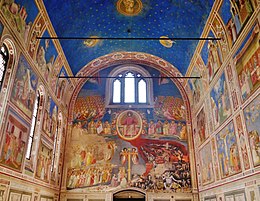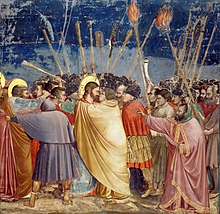
Back كنيسة سكورڤينى ARZ Капэла Скравеньі Byelorussian Chapel ar Scrovegni Breton Capella dels Scrovegni Catalan Kaple Scrovegniů Czech Cappella degli Scrovegni German Capilla de los Scrovegni Spanish نمازخانه اسکروونی Persian Chapelle des Scrovegni French Capele dai Scrovegni FUR
This article includes a list of general references, but it lacks sufficient corresponding inline citations. (April 2020) |
| UNESCO World Heritage Site | |
|---|---|
 The Last Judgment in the Scrovegni Chapel | |
| Location | Padua, Veneto, Italy |
| Criteria | Cultural: (ii), (iii) |
| Reference | 1623 |
| Inscription | 2021 (44th Session) |
| Website | www |
| Coordinates | 45°24′43″N 11°52′46″E / 45.41184°N 11.87952°E |



The Scrovegni Chapel (Italian: Cappella degli Scrovegni [kapˈpɛlla deʎʎi skroˈveɲɲi]), also known as the Arena Chapel, is a small church, adjacent to the Augustinian monastery, the Monastero degli Eremitani in Padua, region of Veneto, Italy. The chapel and monastery are now part of the complex of the Musei Civici di Padova.
The chapel contains a fresco cycle by Giotto, completed around 1305 and an important masterpiece of Western art. In 2021, the chapel was declared part of the UNESCO World Heritage Site of 14th-century fresco cycles composed of 8 historical buildings in Padua city centre.[2] The Scrovegni Chapel contains the most important frescoes that marked the beginning of a revolution in mural painting and influenced fresco technique, style, and content for a whole century.
Cite error: There are <ref group=lower-alpha> tags or {{efn}} templates on this page, but the references will not show without a {{reflist|group=lower-alpha}} template or {{notelist}} template (see the help page).
- ^ Eimerl, Sarel (1967). The World of Giotto: c. 1267–1337. et al. Time-Life Books. p. 109. ISBN 0-900658-15-0.
- ^ UNESCO. "Padua's fourteenth-century fresco cycles, UNESCO declaration". UNESCO. Retrieved 15 August 2021.

